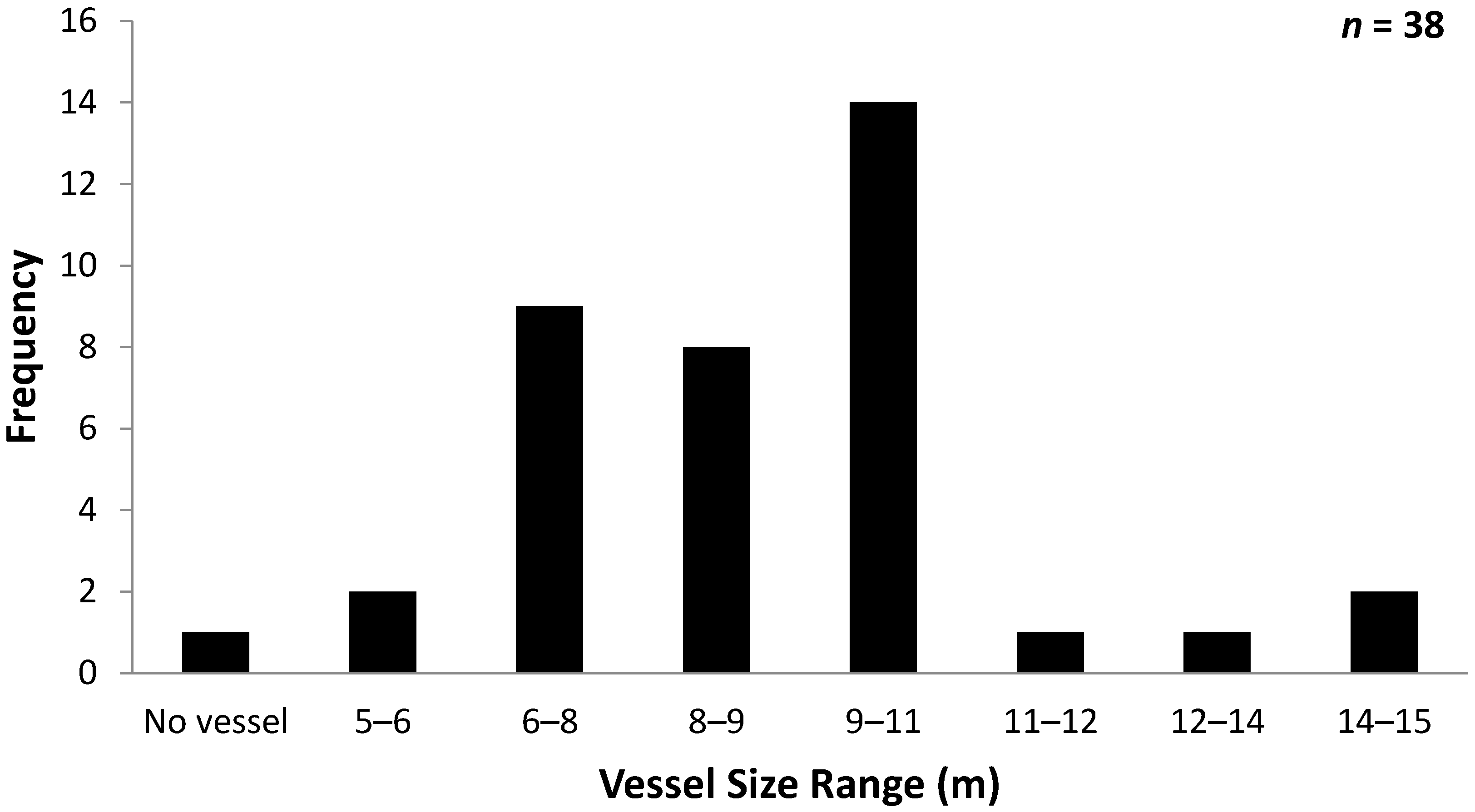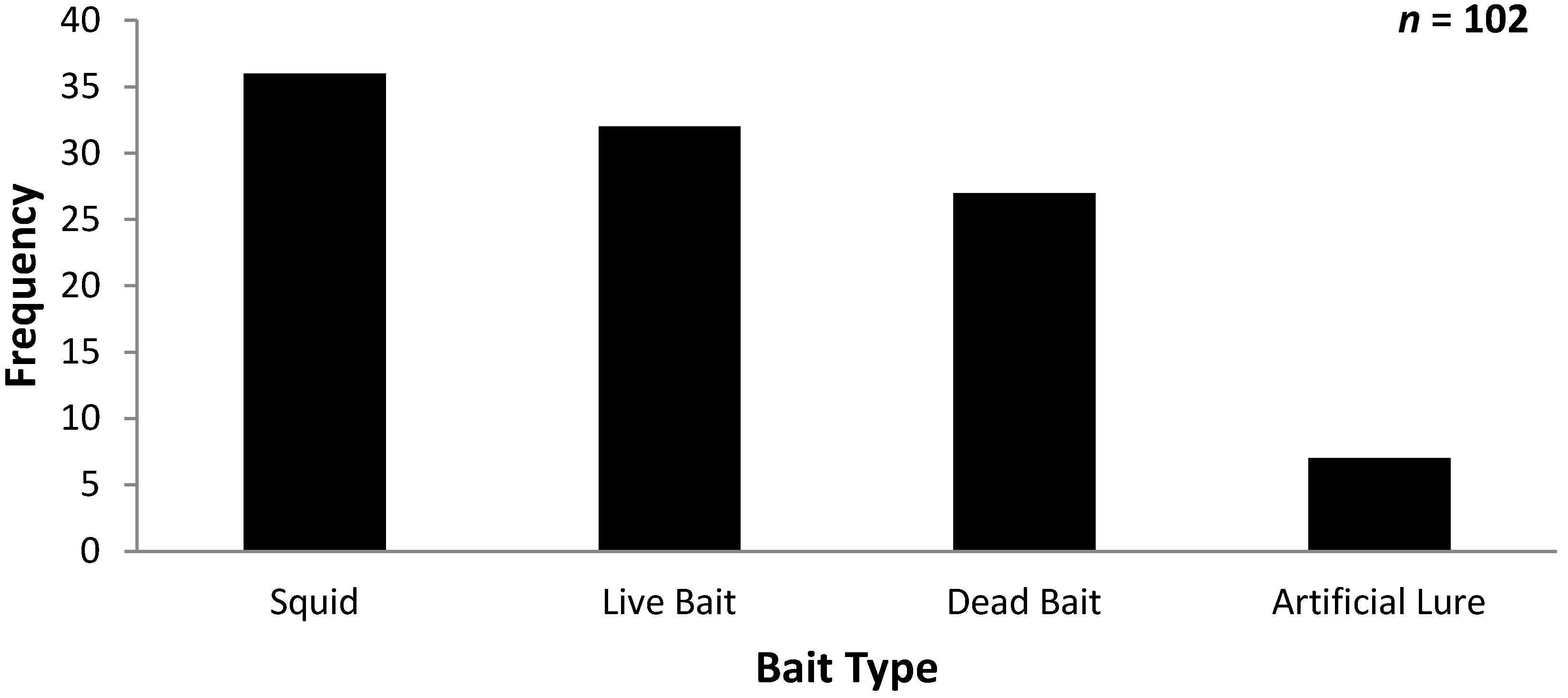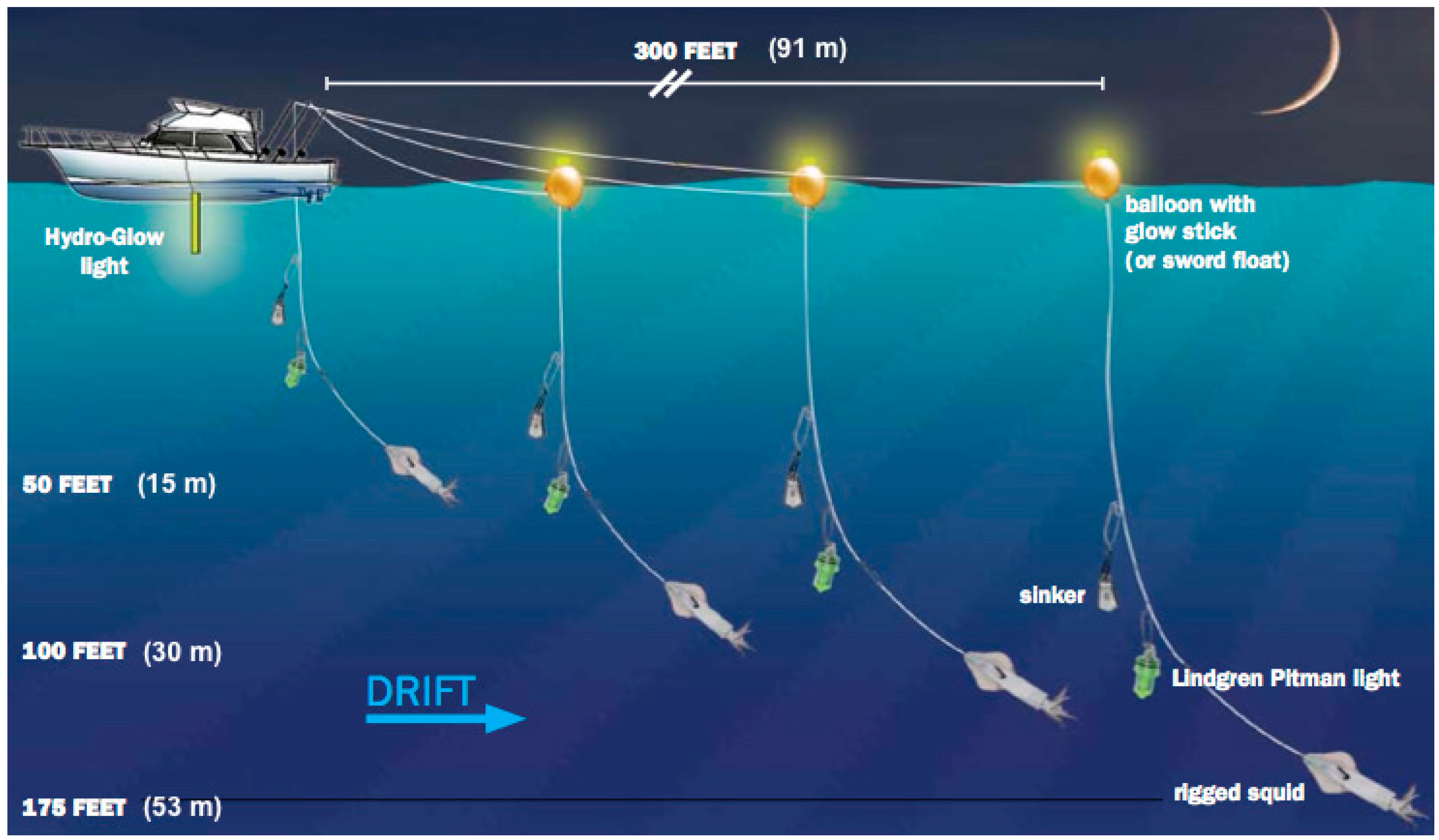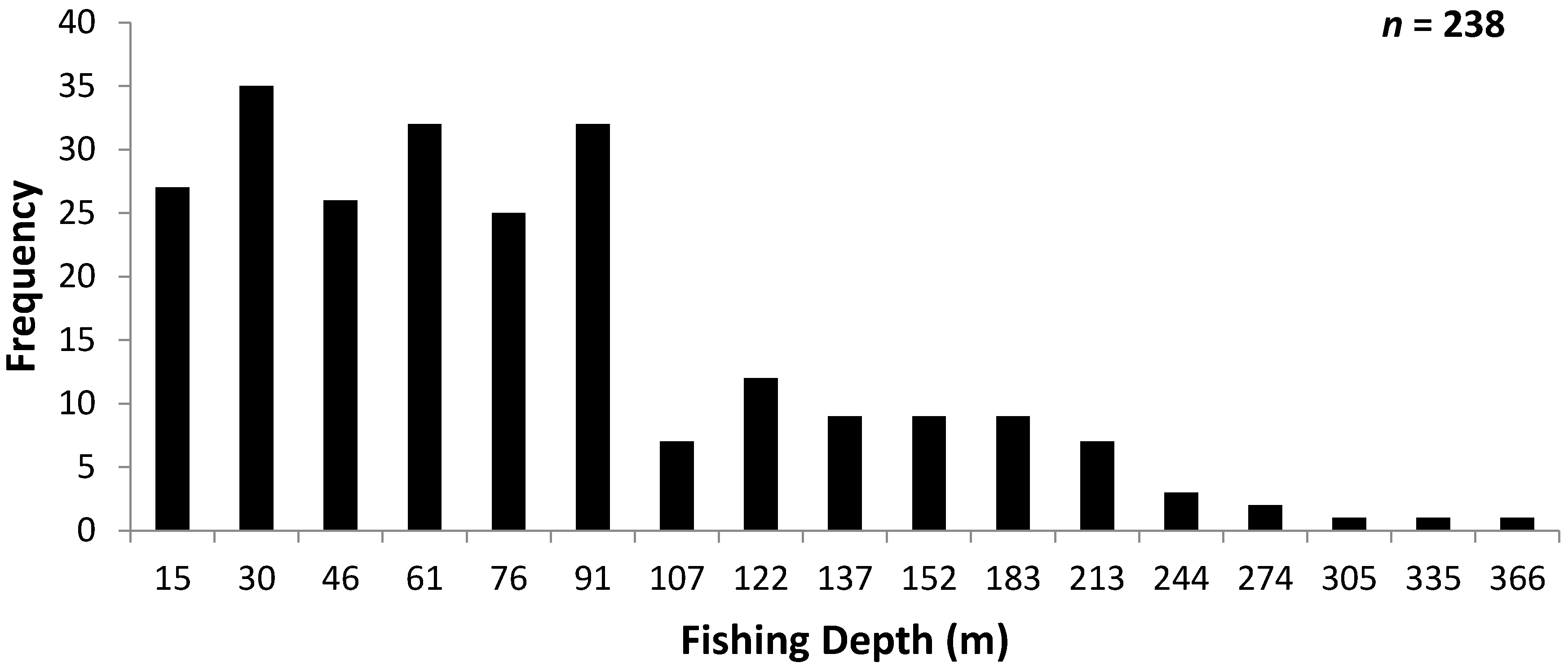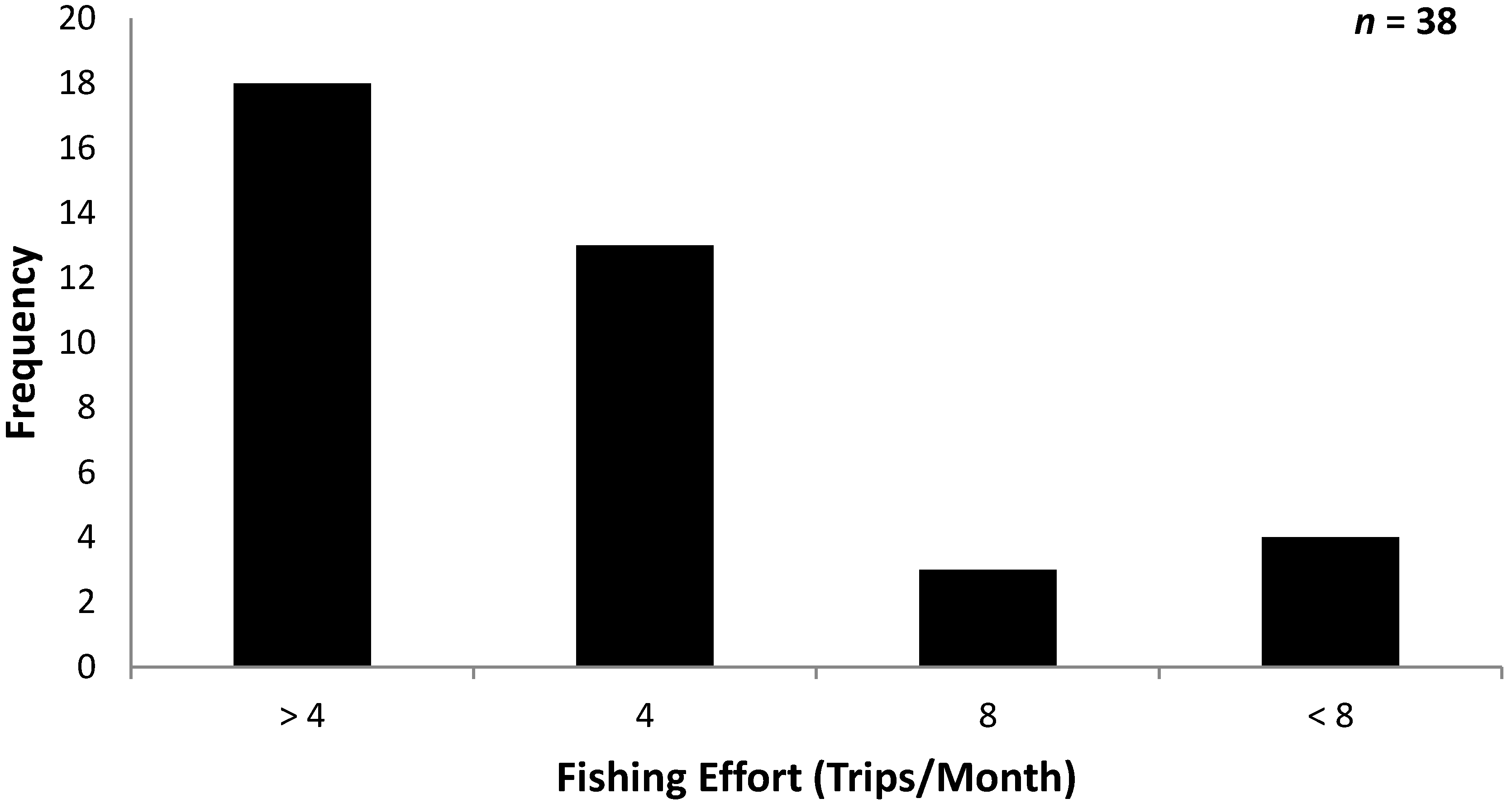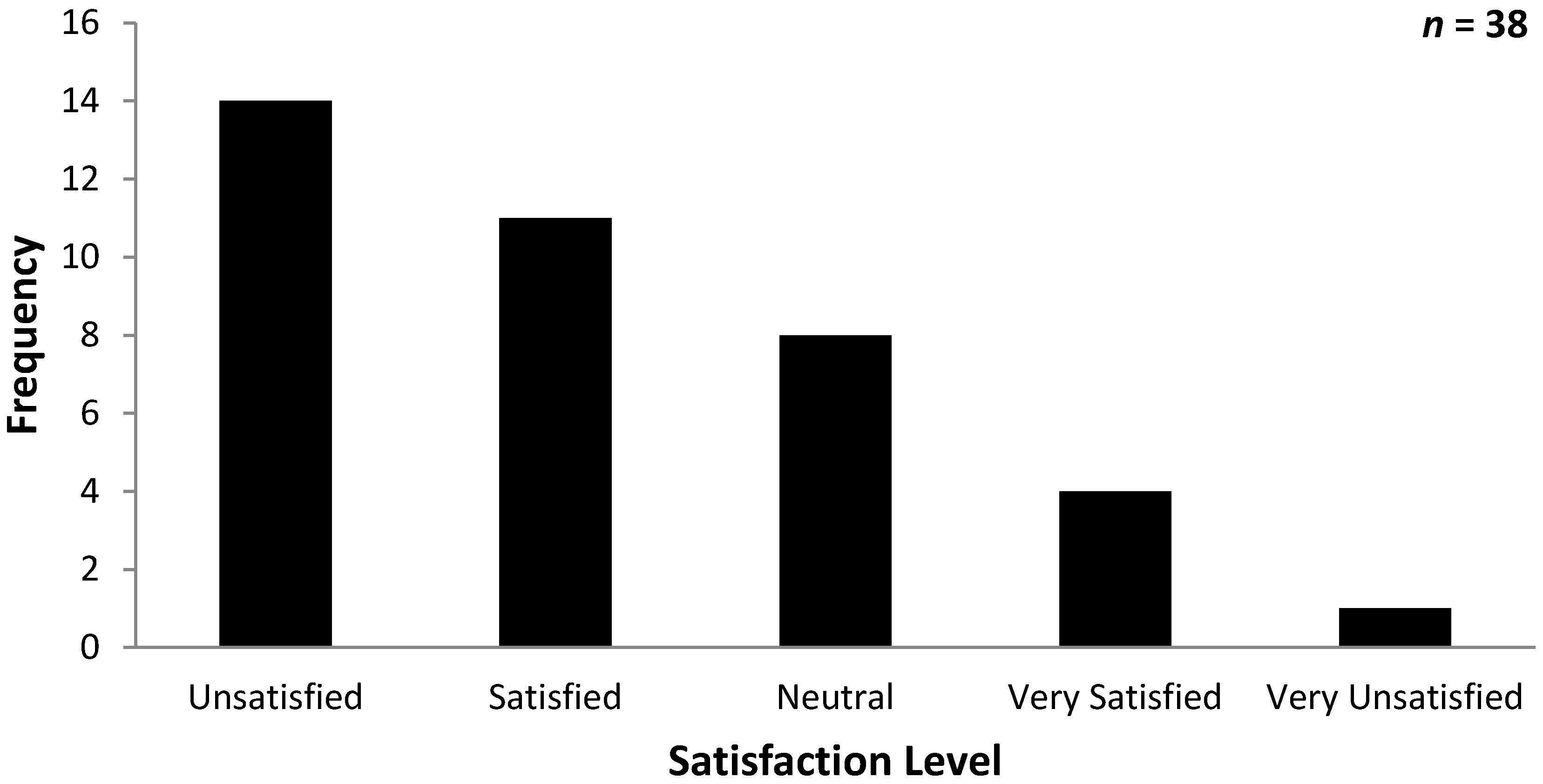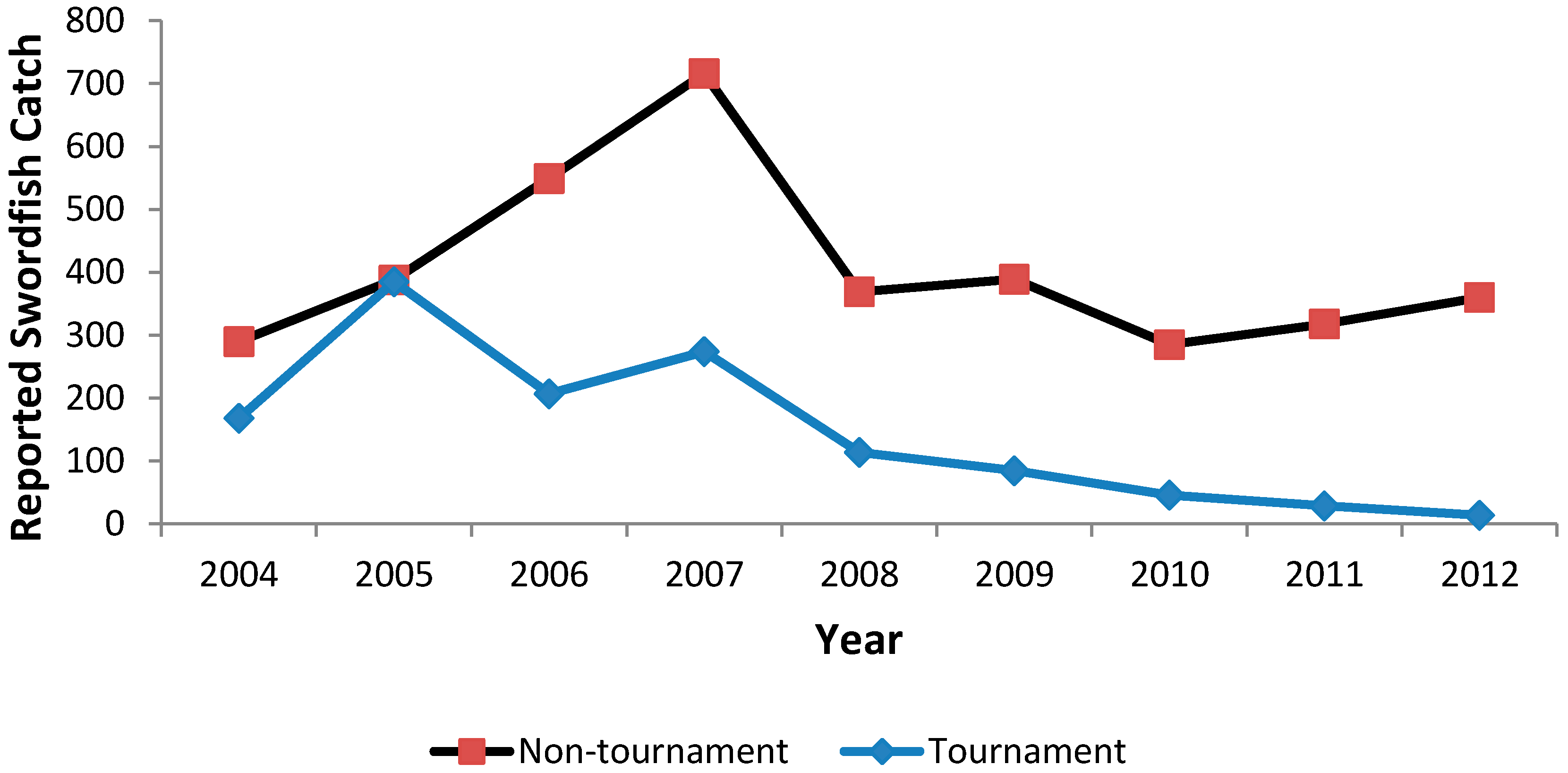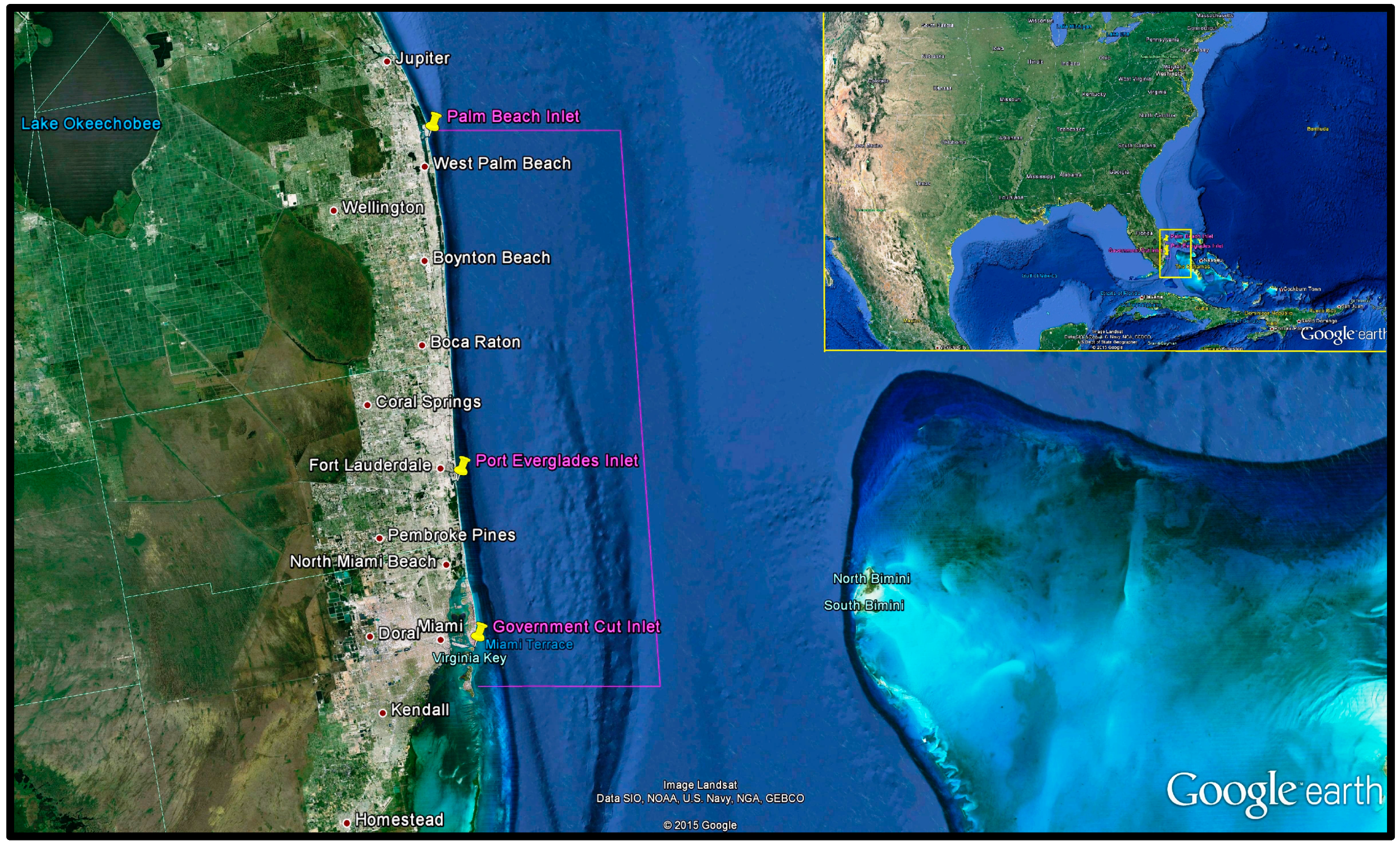1. Introduction
The management of swordfish and other highly migratory species (HMS) in the western North Atlantic Ocean is a multilayered process that involves both domestic and international governing bodies. The primary international governing body overseeing economically valuable commercial fisheries in the Atlantic Ocean is the International Commission for the Conservation of Atlantic Tunas (ICCAT). In the United States, swordfish and other HMS are managed by the National Marine Fisheries Service (NMFS) under the authority of the Secretary of Commerce and various government Acts (e.g., Magnuson-Stevens Act and the Atlantic Tunas Convention Act); NMFS considers domestic and international aspects of these fisheries in the fishery management process [
1]. Considering this complex authority and regulatory process, NMFS implements fishery regulatory measures under the guidance of ICCAT, but it sometimes considers the recommendations by other advisory groups, such as the HMS Advisory Panel (AP). The HMS AP is a diverse group of stakeholders and experts who are knowledgeable about Atlantic HMS and/or Atlantic HMS fisheries; HMS AP members serve three-year terms. The HMS AP has some influence on fishery managers, but it does not have any regulatory authority, unlike regional fishery management councils.
Despite these domestic and international management governing bodies and complex fishery management processes, they were not initially established to manage HMS taken in recreational fisheries in the Atlantic Ocean. Historically, fishery management at the international and federal levels has mainly been directed at commercial fisheries rather than recreational fisheries for a variety of reasons, including the lack of regulatory authority [
2]. Besides size and bag limits, swordfish taken in recreational fisheries in the United States were not strictly regulated or managed until NMFS imposed several measures for recreational anglers in the mid-2000s, such as the HMS Angling or HMS Charter/Headboat Permit, and the requirement to report all billfish (Istiophoridae), swordfish (
Xiphias gladius), and bluefin tuna (
Thunnus thynnus) landed. The Agency also required that every billfish, swordfish, and bluefin tuna landed by recreational anglers had to be tagged with a landings tag prior to unloading it from the vessel (or from the water in the case of trailered vessels). Even though the government implemented these partial requirements for swordfish and other HMS taken in recreational fisheries, adequate data collection programs are still lacking in the United States. Besides the mandatory reporting program for HMS anglers and tournaments, the only other sources of data for HMS recreational fisheries are the Large Pelagic Survey (LPS) and Marine Recreational Information Program (MRIP), which are both interview-based (dock and phone) programs. Recreational anglers are supposed to participate in these surveys to facilitate scientific research and catch monitoring, but many are not interested in assisting even though they are aware that recreational fisheries data for HMS are limited, especially for swordfish.
The swordfish is an economically valuable large pelagic species found in temperate and tropical waters around the world [
1]. Highly migratory in nature, swordfish undertake large-scale horizontal migrations [
3,
4] and demonstrate diel vertical behavior characterized by ascending to the surface and shallow depths during the night and descending to deeper depths during the day [
5,
6]. Dewar et al. speculated these diel behavioral patterns are associated with the deep scattering layer and the availability of prey [
5].
Given their global economic and social value, swordfish are directly targeted by commercial and recreational fisheries [
7]. Swordfish are targeted by many international commercial operations throughout the Atlantic Ocean, but the species is primarily only targeted by recreational anglers along the coast of the United States. In the western North Atlantic Ocean, the commercial fishery began with a few fishermen targeting swordfish during the day with harpoons in the 1920s, but the fishery never fully expanded until the development of specialized commercial fishing gear (i.e., pelagic longline) in the 1960s [
1]. Directed commercial fishing efforts continued to increase during the 1970s through 1980s, and by 1987 swordfish landings peaked in the western North Atlantic Ocean. Shortly thereafter, an evaluation of the swordfish stock revealed it had significantly declined [
8]. To recover the stock, ICCAT immediately implemented a 10-year rebuilding plan for swordfish in the Atlantic Ocean in 1999 that included reductions in the total allowable catch [
1]. In addition, the NMFS instituted a series of time area closures in the Gulf of Mexico and the southeast region of the United States to prevent the bycatch and discarding of HMS species that included juvenile swordfish [
1]. Today, due to the stringent fishery management actions, reduction in commercial fishing effort, and strong recruitment, the most recent stock assessment for swordfish in the Atlantic suggests the stock has recovered and it is at, or above, maximum sustainable yield [
1,
9].
Similar to the commercial fishery, the recreational fishery for swordfish dates back to the 1920s. Initially, it too began with a few recreational anglers in the Northeast United States targeting swordfish on the surface during the day using natural baits [
1,
10]. Despite this modest start, the recreational swordfish fishery did not become well-established off the coast of Florida until the 1970s. Many attribute the expansion of the recreational fishery to the application of commercial fishing techniques, such as drifting natural baits at night [
1]. The recreational fishery continued to increase in popularity, and by the late 1970s nighttime swordfish tournaments were being held off the coasts of Florida, South Carolina, and New Jersey [
1,
11]. Regrettably, even with its growing popularity, the fishery was short-lived due to low and decreasing catch rates in the early 1980s, which was perceived by anglers to be associated with the growing commercial fishing effort off South Florida. In 1983, the last recreational swordfish tournament was held in South Florida [
1,
11]. A few anglers continued to target swordfish off the coast of South Florida during the late-1980s through the 1990s even though organized swordfish tournaments were no longer being held.
In the early 2000s, the recreational swordfish fishery in South Florida resurged for various reasons, including the recovery of the stock, and the re-establishment of nighttime tournaments [
11]. Today, recreational swordfish tournaments and general swordfish fishing efforts off South Florida continue to grow and expand. In fact, South Florida has more dedicated recreational swordfish anglers than any other area in the world [
11]; the Southeast Swordfish Club (SESC) is based in South Florida [
12]. Despite the economic value and rising popularity in targeting swordfish, little data is available describing the recreational swordfish fishery and its socio-economic aspects in South Florida [
1]. Different than commercial fisheries data, limited long-term monitoring programs exist and few governments are equipped to collect recreational fisheries data, which makes it challenging to address potential negative impacts like overfishing undersize immature individuals or post-hook mortality issues; some researchers would argue that recreational fisheries are negatively impacting localized fish populations in similar ways as commercialized operations [
13]. As such, an accurate description of the current recreational swordfish fishery (e.g., fishing effort, landings, and size frequency distribution) is helpful for developing useful and specific management measures for the recreational swordfish fishery. This type of information can also be used to help understand the socio-economics of the fishery, and to test the effectiveness of management decisions with respect to intended objectives. Lastly, this type of information can improve management of this economically valuable fishery by ensuring user group perspectives are understood and incorporated into regulations and best practice recommendations. Given the lack of current fishery information, the overarching goal of this investigation was to describe the recreational swordfish fishery in South Florida. The specific objectives were to compile, identify, and evaluate the demographics, fishing tactics, costs, and fishery management perceptions of recreational swordfish anglers in South Florida.
2. Results
2.1. Angler Demographics
Seventy percent (n = 38) of the recreational swordfish anglers that attended the meetings (i.e., SESC and Hydro Glow Winter Swordfest) participated in the study by completing at least 80% of the 40 fixed-response questionnaire form. As expected, anglers answered more questions about fishing than they did about finances and economics. The sample size (n = 38) represented about 16–38% of the SESC members and between 6% and 8% of the recreational anglers (160 vessels with 3–4 anglers/vessel) that actively targeted swordfish in South Florida (Palm Beach to Key West, Florida) during the time of the survey. Many non-SESC members often attended swordfish fishing seminars given by SESC members so it’s highly likely that non-SESC member fishing techniques mimicked those of SESC members.
Based on the responses, most of the recreational swordfish anglers in South Florida were Caucasian (n = 35 or 95%) followed by Hispanic (n = 1 or 3%) and an unnamed nationality (n = 1 or 3%). The angler’s ages ranged from 21 to 70 (children were excluded (n = 3)), and most (n = 11 or 29%) were between the ages of 41 and 50 followed by ages 51–60 (n = 8). Of the anglers (n = 10) that answered the question about education, 50 and 30% had a bachelor and graduate degree, respectively. The occupational background of anglers was wide-ranging, consisting of healthcare, insurance, communications, transportation, hospitality, self-employment, education, retail, and a few other vocations. Most anglers (n = 20 or 53%) were self-employed. Annual earnings in 2007 ranged from $0–$30,000 to more than $200,000 per year; most (n = 10 or 26%) anglers stated they earned between $30,000 and $60,000 per year. Overall, annual income ranged from $15,000 to $200,000 with an average income of $91,900 per year (upper middle class).
Fishing experience ranged from 1 to 35 years or more, and 60% (n = 26) of polled anglers indicated they had more than 25 years of fishing experience; 34% (n = 13) had more than 35 years. Specific fishing experience in the South Florida swordfish fishery ranged from 1 to 35 years of experience, but most of the anglers (n = 31 or 82%) specified they had less than 10 years of experience. The average fishing experience in South Florida targeting swordfish was 9.4 years and the mode and median was 8 years.
2.2. Fishery Description
Anglers indicated they departed for the fishing grounds from several main inlets located in South Florida ranging from Palm Inlet in the north to Government Cut in the south. Most (
n = 26 or 68%) departed from inlets located in Broward County followed by Palm Beach (
n = 8 or 21%) and Miami-Dade (
n = 3 or 8%) counties. Thirty-seven percent of anglers (
n = 14) departed specifically from Port Everglades, located in Broward County. Anglers did not have a preference for a specific departure port or area, but is should be noted that access to the fishing grounds is generally only accessible through the main inlets in South Florida. Recreational swordfish anglers indicated their fishing vessel length ranged from 4.6–6.1 m (15–20 ft) to more than 14–15 m (46–50 ft). Forty-five percent of the anglers (
n = 17) told us their vessel was a center console and 82 percent (
n = 31) indicated their vessel was between 6.4 (21 ft) and 10.7 m (35 ft) long. Most anglers (
n = 14 or 37%) reported their vessels were between 9.4 (31 ft) and 10.7 m (35 ft) long. The reported vessel length range was not significantly different among anglers (
Figure 1).
Anglers indicated they used several types of bait to target swordfish off South Florida (
Figure 2). Thirty-six percent of anglers specified using squid as bait, while others indicated using a combination of live (32%) or dead (26%) fish or one or the other. A few anglers (6%) used artificial (i.e., trolling) lures to target swordfish. Specifically, anglers stated they preferred using blue runners (
Caranx crysos), bigeye scad (
Selar crumenophthalmus), and tinker mackerel (
Scomber sp.) as live bait. A few (20%) also told us they used live scad (
Decapterus sp.), rainbow runners (
Elagatis bipinnulata), jacks (
Caranx sp.), yellowtail snapper (
Ocyurus chrysurus), pilchards (
Harengula jaguana), and grunts (
Haemulon spp.). Some anglers indicated using dead tinker mackerel (
n = 9), bonito (
Euthynnus alleteratus,
n = 2), and redtail scad (
Decapterus tabl,
n = 2), while others reported using dead blue runners, bigeye scad, jacks, and yellowtail snapper.
Every angler indicated their typical setup included more than one fishing rod (2–9). In fact, 82% of the anglers reported using between five and seven fishing rods, most (34%) preferred a five-rod setup (
F (7, 50) = 15.75,
p < 0.05). To increase catch probability, anglers reported targeting swordfish at night by setting baits at various depths (
Figure 3 and
Figure 4). Overall, anglers set their baits anywhere between 15.2 m (50 ft) and 365.8 m (1200 ft) with 75% (
n = 177) reporting setting their baits at 91.4 m (300 ft) or less (74%) (
Figure 5). The mean fishing depth was 80.7 m (271.4 ft) and the mode was 30.5 m (100 ft).
Sixty-nine percent of the anglers (n = 24) told us they changed their fishing tactics depending on the time of day (sunset vs. night), a few (n = 18 or 47%) changed their technique throughout the season, and some modified their approach from night to day. Based on responses (n = 18 or 47%), anglers altered their fishing technique by changing the fishing depth, but they also indicated changing the bait and fishing location. Seasonal modifications for some anglers (n = 18 or 47%) involved changing their fishing location (n = 4 or 20%) or fishing depth (n = 4 or 20%). Besides reporting daily and seasonal changes, most anglers (n = 24 or 69%) also told us they changed their fishing tactic based on the moon phase. As expected, 67% of the anglers (n = 18) changed their fishing depth according to the moon phase. Some anglers also reported they modified the type (intensity) of light on the leader or the distance between the light and the bait. Other fishing tactic modifications included fishing location and/or fishing effort (i.e., some anglers reported fishing more often during a full moon).
In general, fishing effort ranged from four or less to eight or more fishing trips per month. Most anglers (
n = 31 or 82%) reported pursuing swordfish on four or less fishing trips per month with an average of 1.41 (Standard Error (SE) ± 0.1153) fishing trips per week. Overall, the average number of fishing trips per month and year was 3.37 (S.E ± 0.2669) and 39.00 (S.E ± 3.59), respectively (
Figure 5).
2.3. Economics
Angler Expenses
In 2007, anglers (
n = 8 or 21%) indicated they spent around
$125,000 on fishing vessels purchased specifically to target swordfish in South Florida. In addition, anglers spent another
$7000 on fishing rods and reels, and about
$1700 on other types of capital cost items, such as marine electronics. Anglers indicated some of the annual operational costs included terminal tackle (
$957), fishing line (
$533), and fishing lights (
$276). Anglers also reported spending around
$7680 per year on fuel,
$1716 per year on bait, and
$3042 per year on other running cost expenditures (
Table 1). Most anglers (
n = 21 or 55%) reported spending between
$100 and
$200 on fuel per trip. Overall, anglers spend around
$14,000 per year on swordfishing, which was around 16% of their annual income.
2.4. Fishery Management Satisfaction
Overall, most anglers (
n = 23 or 61%) reported they were neutral, satisfied, or very satisfied with the current recreational swordfish regulations (
Figure 6). However, 39% indicated they were disenchanted with the swordfish regulations as a whole. Some of the reasons for their dissatisfaction included: (1) the government authorizing the use of commercial buoy gear in the Florida Straits; (2) the prospect of the government authorizing commercial longlining in closed zones (i.e., Florida Straits); (3) the minimum size limit was too short to protect large female swordfish; and (4) the bag limit was too large—anglers believed it should be reduced to two fish per vessel instead of four fish per vessel.
Fifty-five percent of anglers (n = 18) favored an increase in the current size limit for swordfish, while others suggested the minimum size should be increased from 119 cm (47 inches) lower jaw fork length (LJFL) to 127 cm (50 inches) LJFL or longer. A few anglers (n = 15 or 45%) supported the current size limit; however, none of them favored a decrease in the swordfish size limit. Most anglers (n = 22 or 63%) did not want a change in the swordfish bag, but some thought a reduction was warranted. Almost every angler (n = 30 or 91%) supported the current regulation requiring anglers to report non-tournament landed swordfish to the NMFS within 24 h of the fishing expedition (i.e., mandatory catch reporting). Overall, anglers indicated they understood the notion that mandatory reporting provided an accurate census of the number of fish landed by recreational anglers. They also told us they understood these data were necessary for management implications associated with the western North Atlantic Ocean ICCAT swordfish quota, which also includes a commercial quota. Interestingly, some anglers also believed mandatory reporting was so important to the management of the fishery that they supported imposing fines to anglers who violated the regulation.
3. Discussion
McGowan et al. stated there are 3 million saltwater anglers in Florida, making it the largest recreational fishery in the world [
15]. Also, the NMFS [
2] reported the economic impact of saltwater recreational fishing in Florida exceeded that of any other state. In Florida, there are also about 4.9 million saltwater anglers [
2] and ≈2000 charter boats and guides that anglers hire to pursue HMS, such as billfish, swordfish, tuna, and sharks [
14]. One of the most popular HMS to pursue in Florida is swordfish, especially in the Florida Straits off South Florida. Despite the importance of recreational HMS fisheries, detailed fisheries data are limited given the lack of enforceable marine policy and associated mandates. According to NMFS [
2], the current federal fishery management system for managing commercial fisheries is inappropriate for recreational fisheries. The report highlighted that NMFS has addressed recreational fisheries inconsistently and a national policy for saltwater recreational fishing that builds upon the current fisheries management system was lacking [
2]. The NMFS [
2] discussed various approaches for managing recreational fisheries that included adopting a new saltwater recreational fisheries management approach, allocating harvestable quota between mixed-sector fisheries (commercial and recreational), creating reasonable stock rebuilding timelines, and codifying a process for cooperative management.
To implement these recommendations, NMFS needs additional and more specific data on recreational fisheries. The NMFS does oversee the MRIP, but comprehensive data describing the fishery, fishing (tactics and gear), and socio-economics are unavailable, such as the recreational swordfish fishery. Supporting this management need, we conducted this study to provide updated information about swordfishing and the socio-economics associated with the recreational swordfish fishery in South Florida. We acknowledge the sample size was small (n = 38), but we still believe the study encompassed the most experienced and knowledgeable anglers in South Florida that regularly target swordfish. As previously discussed, we distributed our questionnaire form at meetings of the SESC, which is the largest fishing club dedicated to swordfishing in Florida and possibly the world. As stated in the methods and results, we are confident the members represented the South Florida recreational swordfishing population given their knowledge, expertise, and connection with the fishery in terms of participants, fishing effort, and fishing techniques.
Based on our interviews, swordfish are among the most popular recreational species in South Florida given their sporting qualities (e.g., large size and epic angling battles) and the financial costs anglers are willing to spend to target this pelagic species. Although swordfish are found around the world, South Florida is one of the only locations that supports a stable directed recreational fishery [
11]. Recreational anglers are able to pursue swordfish off South Florida given their abundance in the Florida Straits and the proximity to productive fishing grounds.
The results of this study indicate that swordfish anglers were experienced, with the majority having more than 25 years of fishing experience. Most of the anglers were Caucasian and a few were Hispanic; their annual income was classified as upper middle class. Overall, this is consistent with the general demographics and experience level reported for other anglers pursuing offshore big game species (billfish and tuna) in the United States; most of the anglers had more than 20 years of recreational fishing experience [
16,
17]. It is highly probable that many of the anglers are very experienced because swordfish are among the largest fish in the world; it takes specific tactics and great skill to land these fish. It also requires disposable income, large vessels, specialized techniques, and equipment that many nearshore, amateur or inexperienced anglers do not possess. Although most polled anglers had more than 20 years of recreational fishing experience, many had less than 10 years’ experience specifically targeting swordfish. Again, this is consistent with the rapid resurgence of interest and effort that has occurred in the past 10 to 15 years. Levesque and Kerstetter reported that swordfish tournaments resumed in 2001 after being discontinued for 18 years [
11]. In terms of basic fishing inlets, fishing grounds, vessel size, and general fishing techniques, our results agreed with Levesque and Kerstetter [
11].
To target and successfully land these large and powerful fish requires a variety of specialized recreational fishing gear that is costly. In fact, the findings showed that it requires a high capital investment and operational costs that exceeds most recreational fisheries in Florida [
18,
19]. Given these high costs, it is likely the fishery provides important economic benefits to local and regional economies. Many researchers have reported that distinct fishing destinations provide valuable inputs to local, state, and regional economies [
16,
17]. Providing millions of dollars to the regional economies (e.g., Guatemala, Costa Rica, and Cabo San Lucas, Mexico), billfish are among the most highly prized big game fish in the world [
16,
18]. Based on this study, and our knowledge about recreational fishing, there are relatively few destinations in the world like South Florida where anglers can target and regularly encounter swordfish. Since the resurgence of the fishery in the early-2000s, its popularity has quickly increased, and currently there are more local fishing clubs, online forums, and tournaments in South Florida dedicated exclusively to the pursuit of swordfish than any other place in the world.
Responses from polled anglers showed that baits utilized by anglers are similar to those traditionally used in commercial and other offshore recreational fisheries in Florida. Our study showed that squid was the most popular bait; squid are also used in most commercial longline and recreational fisheries targeting swordfish [
11,
20,
21]. Anglers also reported using various live baits, such as bigeye scad and blue runners, which are commonly used to target other pelagic species (sailfish,
Istiophorus albicans) [
22]. South Florida anglers also reported using mackerel as bait, which are common bait in commercial swordfish and recreational fisheries [
19,
20]. In general, it appears that some fishing tactics (bait) have not changed over time [
11]. Interestingly, some anglers told us they targeted swordfish at night using artificial lures and various trolling techniques. It is difficult to guess whether this tactic will become more popular with time, but many anglers are secretive and tend to keep productive techniques to themselves.
Polled recreational anglers targeting swordfish in South Florida varied somewhat in their views and opinions about the current Federal swordfish regulations. Acknowledging the historical status of the swordfish fishery and management, we were surprised that 61% of anglers surveyed were very satisfied, satisfied, or neutral in their opinions about the current fishing regulations associated with swordfish. Despite our initial impression, these results were similar to previous saltwater recreational fishing surveys. For instance, Ditton et al. reported that 67% of recreational bluefin tuna anglers in North Carolina were supportive of the fishery regulations at the time [
16]. Based on the open-ended responses provided by some of the respondents in this survey, many of the swordfish anglers indicated there were two main reasons they were dissatisfied with the current regulations: (1) commercial fishing activity off South Florida; and (2) the need for increased regulations in the recreational fishery. Specifically, some of the anglers expressed they were dissatisfied with the continued authorization of commercial buoy gear in the Florida Straits. They were also concerned about the prospect/rumors of the re-opening of the Florida Straits to commercial pelagic longlining. Anglers also thought size limits should increase and bag limits should decrease; however, anglers also mentioned they were concerned about large female swordfish.
Overall, most of the respondents were in favor of increasing the current federal size limit for swordfish (119.4 cm LJFL). Some respondents were satisfied with the current size limit and none supported the need to decrease the size limit. Remarkably, some anglers also suggested creating a slot limit for swordfish, which is a typical fishery management measure in recreational fisheries. According to Taylor and Murphy [
23], most swordfish larger than 2.3 m LJFL are female, which suggests that the waters off South Florida are an important spawning ground for the North Atlantic swordfish. Thus, regulations protecting large, sexually mature female swordfish off South Florida may be beneficial and warranted.
To our knowledge, this is the first study to reveal the basic socio-economics associated with the swordfish fishery in South Florida. Until now, basic information on the recreational swordfish fishery has been limited given most of the methods used to collect fishery information not only have been general in terms of all HMS, but voluntary, which is often problematic. Primarily, NMFS has relied upon the LPS to gather information on HMS recreational fisheries, but the program covers a large geographic region and the chances of specifically polling a swordfish angler in South Florida is low given the way the program is administered [
1]. Under the LPS, telephone and intercept surveys are administered to gather information on fishing effort, target species, location, fishing techniques, and conditions; but respondents are not specifically asked detailed socio-economics or swordfishing tactic questions [
1]. For the first time, our study provides this type of information; socio-economic information and updated swordfishing tactic details.
Taking into account the problems with gathering voluntary recreational fishery information for HMS, the NMFS is constantly evaluating different options to improve the way they collect data. In recent years, the Agency implemented various mandated fishery management measures to help gather more data on HMS recreational fisheries, such as the Atlantic HMS permit (Angling, Charter/Headboat, and Atlantic Tunas General categories) system. One of the reasons the NMFS implemented this requirement was so they could estimate fishing effort. The Agency also implemented mandatory reporting for HMS. Tournament and non-tournament recreational anglers are supposed to report all of their HMS landings to NMFS within 24 h of a fishing trip, which does include swordfish. Despite this requirement, it’s difficult to know with certainty whether all recreational anglers are reporting their catch. Data collected under this program indicates that recreational swordfish landings have varied over the past decade. Non-tournament landings ranged from 285 in 2010 to 716 swordfish in 2007 with a mean of 407 swordfish per year during 2004 through 2012 [
24]. Tournament landings (2002–2012) ranged from 14 in 2012 to 385 swordfish to 2005 with a mean of 126 swordfish per year ([
24];
Figure 7). Overall, we support these requirements, but recommend further refinement. It would also be useful for the Agency to periodically conduct specific surveys for HMS in hot spot fishing regions, such as South Florida.
5. Conclusions
The management of swordfish and other HMS in the western North Atlantic Ocean is a multilayered process that involves both domestic and international governing bodies. Despite these domestic and international management governing bodies and complex fishery management processes, they are set up primarily to regulate HMS that are taken in commercial fisheries in the Atlantic Ocean. Thus, additional policy and procedure are necessary to manage HMS taken in recreational fisheries, especially since they continue to expand throughout the United States.
Recreational fishing continues to grow in popularity, but Florida leads the country in the number of saltwater anglers. Today, South Florida is a world-class destination for recreational anglers targeting swordfish. In South Florida, unlike other locations, the fishing grounds are relatively close to the coast, which allows anglers with a wide range of vessels to easily target swordfish. The popularity of swordfishing off South Florida has increased over the past 15 years. Given this demand, our study demonstrates that swordfish are a popular and economically valuable recreational species for South Florida anglers; it showed anglers are willing to spend a large portion of the annual income to pursue swordfish. While this study focused on the costs involved with participating in the recreational swordfish fishery, it did not specifically address the economic impact of the fishery on the local and regional economy. Nonetheless, revenue associated with the recreational swordfish fishery typically exceeded those of other recreational fisheries in Florida [
18]. Although our survey and associated sample size had limitations in terms of the population and potential for bias, we believe the information provided by this study has merit given the specifics about the fishery. Unlike with other pelagic species, fishing techniques and costs are very specific to swordfishing. In general, it is also a much smaller segment of the South Florida recreational fishery; it is very specialized. We believe most of the avid, most-experienced, and knowledgeable swordfish anglers are members of the SESC. As such, it is highly likely that the information gathered through our survey represents most of the fishery in terms of gear, techniques, fishing effort, and socio-economics. Obviously, we note that further research is necessary to determine the total economic impact of the fishery to local and regional economies. Also, based on recent interviews, we believe a description of the daytime deep-drop fishery is now necessary so that fishery managers can better understand the potential implications associated with this tactic.
Based on these findings and recent data collected by NMFS [
24], it is apparent that recreational anglers have become very proficient at targeting and catching swordfish during both day and night in South Florida. It also appears that fishing methods are continuing to evolve, allowing anglers to target larger swordfish during the day, which tend to be female individuals. Fishing pressure is continuing to not only increase in South Florida, but fishing techniques have been adapted and used successfully in other regions, including the Gulf of Mexico. Currently, information is lacking describing these new techniques or the range of the fishery, but additional research could serve to characterize new fishing techniques, and any potential management implications arising from changes in the fishery.
